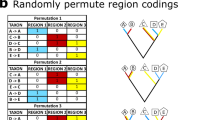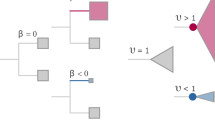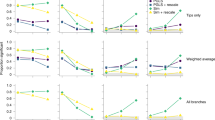Abstract
Arising from: R. E. Ricklefs Nature 430, 338–341 (2004); Ricklefs replies. Ricklefs1 claims to show that morphological evolution in birds is associated with speciation events — that is, it is punctuational — by inference from data on only species number, clade age and character variance from a range of passerine clades. He suggests that variance increases in proportion with clade age under gradual change, but in proportion to the logarithm of species number if change is punctuational. Here I show that both clade age and the logarithm of species number independently predict variance under both gradual and punctuational change, rendering Ricklefs' results uninformative about his central hypothesis.
Similar content being viewed by others
Main
First, I simulated 100 clades that survived to the same age (60 units) under a constant-rates birth–death process (speciation rate, 0.2; extinction rate, 0.16). Trees contained from one species (excluded from analyses) to 238 species (mean, 49.3). I evolved two characters on each tree under brownian motion — one gradual, the other changing only at speciation. Log(species number) is a highly significant predictor of variance in the evolved trait under both gradual (t96=5.42, P<0.0001, r2=0.23) and punctuational change (t96=7.57, P<0.0001, r2=0.37), even among clades of the same age.
Second, I evolved 100 surviving clades until they reached a fixed size (50 extant species) by using the same process and evolved characters as before. Clade age ranged from 23.7 to 176.2 time units and significantly (though weakly) predicted variance in the evolved trait under both gradual (t98=2.03, P=0.046, r2=0.03) and punctuational (t98=2.32, P=0.02, r2=0.04) models, even among clades of the same size.
These results are not surprising. Under gradual change, variance accumulates along phylogenetic branches2. Larger clades have more total branch length within them, even in same-aged clades (across my trees, Spearman's r=0.98), and so have more variance in gradually evolved traits. With punctuational change, variance accumulates only at speciations, but older clades have experienced more speciation (and extinction) events — even in same-sized clades — to an extent that depends on the extinction rate3. Clade age is therefore a good predictor of number of speciations across the same-sized trees (Spearman's r=0.81).
Ricklefs1 found that log(species number) but not clade age independently predicted morphological variance in multiple regressions, and concludes from this that morphological evolution in birds seems to be associated with cladogenesis. However, my simulations show that his significant results for log(species number) are expected under both models. Further, both models predict that clade age too will correlate with variance, but Ricklefs found no significant association. Why not? Ricklefs proposes a model in which speciation promotes gradual divergent change. It is unclear what predictions his model makes about his data. Alternatively, the negative result may simply be a type II error. Clade age was only weakly predictive of variance in my simulations, and the phylogeny from which the clade ages are taken4 conflicts markedly with more recent evidence5.
The mode of character evolution can sometimes be inferred using detailed phylogenetic information3,6,7. Clade ages and species numbers alone are not enough.
References
Ricklefs, R. E. Nature 430, 338–341 (2004).
Felsenstein, J. Am. Nat. 125, 1–15 (1985).
Bokma, F. J. Evol. Biol. 15, 1048–1056 (2002).
Sibley, C. G. & Ahlquist, J. E. Phylogeny and Classification of Birds: A Case Study of Molecular Evolution (Yale Univ. Press, New Haven, Connecticut, 1990).
Barker, F. K., Cibois, A., Schikler, P., Feinstein, J. & Cracraft, J. Proc. Natl Acad. Sci. USA 101, 11040–11045 (2004).
Mooers, A. Ø., Vamosi, S. M. & Schluter, D. Am. Nat. 154, 249–259 (1999).
Pagel, M. Nature 401, 877–884 (1999).
Author information
Authors and Affiliations
Corresponding author
Rights and permissions
About this article
Cite this article
Purvis, A. How do characters evolve?. Nature 432, 166 (2004). https://doi.org/10.1038/nature03092
Published:
Issue Date:
DOI: https://doi.org/10.1038/nature03092
This article is cited by
-
Disparity and Evolutionary Rate Do Not Explain Diversity Patterns in Muroid Rodents (Rodentia: Muroidea)
Evolutionary Biology (2018)
-
Phylogenetic analyses suggest that diversification and body size evolution are independent in insects
BMC Evolutionary Biology (2016)
-
Evolution of Cranial Shape in Caecilians (Amphibia: Gymnophiona)
Evolutionary Biology (2014)
-
Punctuated equilibrium in a neontological context
Theory in Biosciences (2010)
-
How do characters evolve? (reply)
Nature (2004)
Comments
By submitting a comment you agree to abide by our Terms and Community Guidelines. If you find something abusive or that does not comply with our terms or guidelines please flag it as inappropriate.



